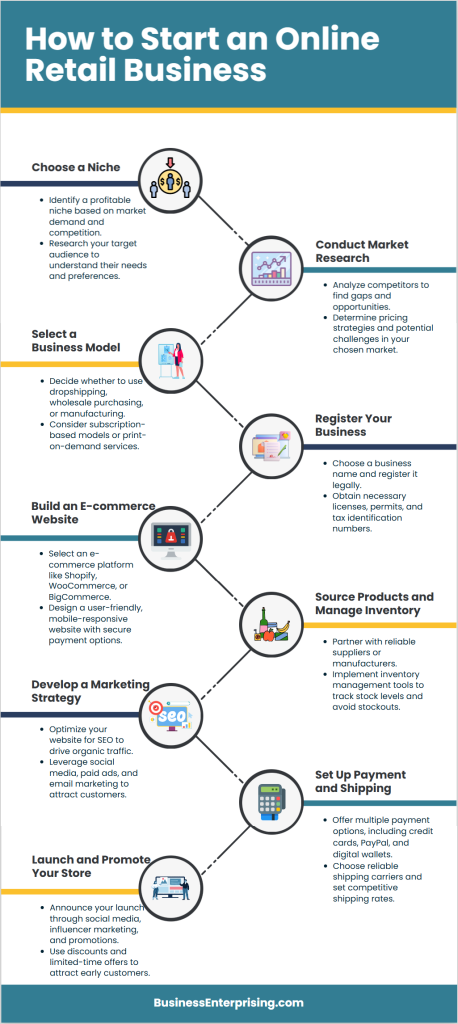
You’ll need a user-friendly e-commerce platform to showcase your brand and simplify transactions. Additionally, prioritize mobile optimization, as many shoppers browse on phones. Focus on clear branding to stand out in crowded markets.
Sourcing products efficiently and managing inventory prevents stockouts or overspending. Marketing strategies like SEO and social media help attract customers early. Over time, loyalty programs keep them returning.
Adaptability matters, as trends and customer needs shift quickly. By focusing on clear goals and customer value, you position your business for long-term success. Whether you’re launching a new idea or expanding an existing venture, this article offers practical insights for starting an online retail business.
Identifying Your Niche and Target Audience
Identifying your niche and target audience is the first step in starting an online retail business. Without this focus, you risk competing in oversaturated markets. To research profitable niches, analyze trends using tools like Google Trends or Amazon Best Sellers. Look for consistent demand paired with manageable competition. Additionally, study customer reviews in potential niches to spot unmet needs or recurring complaints. This approach helps you refine your product ideas.
Next, assess market demand by evaluating search volumes and social media discussions. Keyword research tools like SEMrush or Ubersuggest can reveal what people actively seek. Similarly, platforms like Reddit or Facebook Groups provide unfiltered insights into customer interests. Narrow your focus to a specific audience segment. For example, instead of targeting “fitness enthusiasts,” consider “busy parents seeking home workout solutions.” This specificity strengthens your positioning.
To understand customer demographics, use surveys or analytics tools like Google Analytics. Tools such as SparkToro or Facebook Audience Insights clarify age, location, and buying habits. Identify pain points by analyzing feedback forums or competitor reviews. Prioritize preferences by testing product concepts with small focus groups. Remember, your goal is to align offerings with what your audience truly values.
Finally, validate your niche by testing demand with a minimal viable product or pre-orders. Adjust based on early feedback before scaling. Transitioning into execution becomes smoother once you confirm a viable audience. Overall, thorough research reduces risks and sharpens your strategy for starting an online retail business.
Creating a Business Plan and Budget
Creating a business plan and budget is foundational when starting an online retail business. First, outline your financial projections by estimating monthly sales, expenses, and profit margins. Base these numbers on market research to keep them realistic. Next, list all startup costs, such as website development, inventory, and marketing. Break them into one-time and recurring expenses to avoid surprises. Additionally, define your revenue model clearly. For example, decide if you’ll use subscriptions, one-time sales, or a mix.
To secure funding, explore options like small business loans or lines of credit. Many lenders require a detailed business plan, so prepare yours with clear data. Alternatively, pitch to investors by highlighting your unique value and growth potential. If external funding feels risky, consider bootstrapping. This approach lets you retain control but may limit early scalability.
Use free tools like spreadsheet software to track your budget and adjust projections as you test assumptions. For instance, compare actual sales to forecasts monthly. Similarly, revisit expenses regularly to cut unnecessary costs. Transitioning from planning to action becomes easier when you have a financial roadmap.
Remember, flexibility matters. If early sales fall short, tweak pricing or marketing strategies. Always keep cash reserves for unexpected challenges. By balancing structure and adaptability, you build a stronger foundation for starting an online retail business.
Choosing the Right E-commerce Platform
Choosing the right e-commerce platform shapes your success when starting an online retail business. First, compare options like Shopify, WooCommerce, and BigCommerce. Shopify offers simplicity with drag-and-drop editors and built-in hosting. Alternatively, WooCommerce integrates with WordPress, giving you full control if you prefer customization. Meanwhile, BigCommerce balances ease of use with advanced features for scaling.
Prioritize scalability to support future growth. For example, check if the platform handles increased traffic or product lines smoothly. Additionally, review payment gateway options to accept multiple currencies and methods. SEO tools also matter, as they help improve visibility in search results.
Consider costs beyond monthly fees. Some platforms charge transaction fees, while others require plugin purchases for basic features. Test free trials to gauge usability. If you lack technical skills, avoid overly complex systems. Focus on platforms that align with your budget and goals.
Finally, assess customer support quality. Reliable help prevents downtime during critical moments. Transitioning platforms later can disrupt sales, so choose carefully upfront. By balancing features and flexibility, you lay a strong foundation for starting an online retail business.
Building Your Brand and Online Presence
Building a strong brand and online presence matters when starting an online retail business. First, craft a memorable brand identity by defining your values and voice. Keep messaging consistent across all channels to build trust. Design a simple logo that reflects your mission. Avoid overly complex visuals that might confuse customers.
Next, create a user-friendly website. Prioritize clean layouts and intuitive navigation. Make sure pages load quickly, as slow sites drive visitors away. Additionally, optimize every element for mobile devices. Mobile users make up a large share of online shoppers, so test your site on multiple screens.
Focus on readability and clear calls to action. Use high-quality images, but compress files to maintain speed. However, avoid clutter that distracts from your products. Include an easy checkout process to reduce cart abandonment.
Also, integrate your brand into social media profiles and content. Share stories that align with your values to connect emotionally. Regularly update blogs or videos to keep your audience engaged.
Finally, monitor feedback to refine your approach. Tools like heatmaps show how users interact with your site. Adjust designs based on real behavior. By focusing on these elements, you build trust and recognition when starting an online retail business.
Sourcing Products and Managing Inventory
When starting an online retail business, sourcing products and managing inventory are critical tasks. You have several options for sourcing products: dropshipping, wholesalers, or manufacturing. Dropshipping allows you to sell products without holding inventory; instead, suppliers ship directly to your customers. Alternatively, purchasing from wholesalers enables you to buy in bulk at discounted rates, storing products until sold. Manufacturing involves creating your own products, offering complete control over quality and branding.
Effective inventory management prevents stockouts and overstock situations. Utilizing inventory management tools can help you monitor stock levels, forecast demand, and automate reordering processes. Implementing strategies like setting reorder points ensures timely replenishment. Additionally, conducting regular audits helps maintain accurate inventory records. By aligning your sourcing method with robust inventory practices, you can meet customer demand efficiently.
Marketing Strategies and Customer Acquisition
When starting an online retail business, implementing effective marketing strategies is essential for attracting and retaining customers. Leveraging search engine optimization (SEO) enhances your website’s visibility, driving organic traffic. Additionally, engaging with potential customers on social media platforms allows you to showcase products and build brand awareness. Email marketing campaigns further enable you to reach your audience directly with personalized offers and updates.
Retaining customers is equally important. Implementing loyalty programs rewards repeat purchases, encouraging customers to return. Moreover, post-purchase engagement, such as personalized follow-up emails or exclusive offers, fosters a sense of connection and satisfaction. By focusing on these strategies, you can effectively attract and retain customers when starting an online retail business.
Conclusion
Starting an online retail business requires careful planning and execution. However, sourcing products, managing inventory, and marketing effectively can set you up for success. Additionally, using SEO, social media, and email marketing helps attract and retain customers. By leveraging these strategies, you create a strong foundation for long-term growth.
Retaining customers is just as important as acquiring them. Therefore, loyalty programs and post-purchase engagement can increase repeat business and customer satisfaction. Additionally, tracking performance and adjusting strategies over time helps maintain steady progress. Consistency in customer communication strengthens brand trust and improves retention.
Every successful online store adapts to changing trends and customer preferences. Therefore, staying informed and flexible allows you to refine your approach. By focusing on product quality, marketing strategies, and customer relationships, you increase your chances of sustained success.



